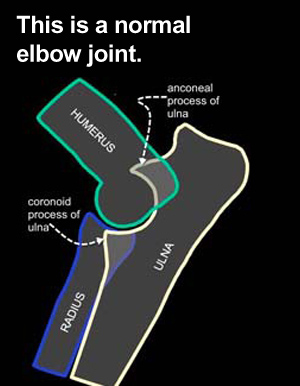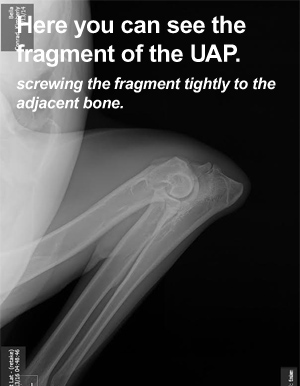Elbow dysplasia is becoming more common in the canine world, according to statistics from the Orthopedic Foundation for Animals. While not as well known as hip dysplasia, it is still an important cause of lameness with a genetic component.
There are three types of canine elbow dysplasia depending on the location in the joint where the defect is found. These types are big names that are intended to identify the location and type of defect.
– Ununited anconeal process (UAP)
– Fractured coronoid process of the ulna (FCP)
– Pathology of the medial condyle of the humerus (OCD)
Surgical repair entails screwing the fragment tightly to the adjacent bone.


Canine Elbow Dysplasia can be confusing because of the variability in clinical signs. For example, an 8-month-old puppy may show lameness and pain on elbow manipulation, but no radiographic abnormalities. Arthroscopic surgery may reveal abnormal cartilage which can then be corrected. On the other hand, a 3-year-old dog that the owner never thought was lame may undergo survey radiographs for OFA only to find a large fragment present in the joint. This finding leads to an orthopedic exam where the dog is lame to a veterinarian’s trained eye, and obviously painful to manipulation of the joint. If left untreated, this fragment will lead to severe arthritic changes that will be impossible to repair.
It is extremely important to have lamenesses evaluated by your veterinarian early and not wait for months, even if the lameness is mild. Elbow dysplasia can rapidly lead to arthritis, which is always progressive. If arthritis has begun before the defect (for example, a fragment) can be stabilized or removed, the arthritis will still continue to progress, even after the surgical repair. Early diagnosis, aggressive treatment, and appropriate rehabilitation/physical therapy is key to an excellent recovery.
 A major downside of the internet pharmacies is that many dog owners feel free to do their own diagnostics and treatment, their dogs do not see the veterinarian as much as they should and many cases of dysplasia are not identified until it is too late for a decent recovery. Much like canine hip dysplasia, genetics, nutrition, and exercise are important components to the development of this disease. ED is difficult to manage surgically or medically.
A major downside of the internet pharmacies is that many dog owners feel free to do their own diagnostics and treatment, their dogs do not see the veterinarian as much as they should and many cases of dysplasia are not identified until it is too late for a decent recovery. Much like canine hip dysplasia, genetics, nutrition, and exercise are important components to the development of this disease. ED is difficult to manage surgically or medically.
Be sure to only buy puppies from ED normal parents. This status can be verified by going to the OFA website and entering the individual’s name into the search box for health tested dogs. Be sure to keep puppies light in their body condition and be careful to not allow too much fast and aggressive exercise for at least the first year while bones and joints are developing. If you suspect your dog may have a lameness issue, contact your regular veterinarian or local rehabilitation veterinarian for an evaluation as soon as possible.

Recent Comments